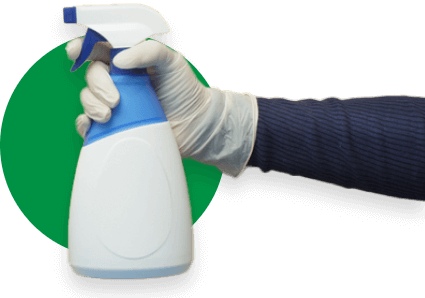To prevent office mold, focus on controlling moisture, improving ventilation, and scheduling routine professional cleaning. These steps not only prevent spores from spreading but also improve office air quality, protect employee health, and maintain a safe and productive environment year-round.
Why Preventing Mold in Offices Matters
Mold isn’t just a maintenance issue; it’s a workplace hazard. Left unchecked, it can quietly damage your building, your business reputation, and the health of your employees.
Let’s start with the human side. Mold releases microscopic spores into the air that trigger allergies, worsen asthma, and cause fatigue, headaches, and brain fog. When your team doesn’t feel well, productivity tends to dip. Sick days increase. Morale drops. And it doesn’t take long before someone starts asking, “What’s that smell?”
For building owners and property managers in the DFW area, workplace mold causes more than just discomfort. Moisture damage compromises drywall, ceilings, flooring, and HVAC systems. Repair costs can spike rapidly, and insurance companies may deny claims if they deem the mold to be preventable.
Then there’s liability. OSHA doesn’t set specific mold exposure limits, but failure to address it may violate general duty clauses. If employees become ill, you may face legal consequences. Mold also impacts perception. Clients and tenants associate musty odors with neglect, and nobody wants to rent or renew in a building that feels unclean.
Common Sources of Workplace Mold
Most mold problems start small but can escalate quickly, often beginning in the most predictable places. While any damp area is a risk, office restrooms and kitchens are typically the most common starting points due to their constant water use and humidity. Understanding all the potential sources is the first step to effective prevention in your workplace:
- High Humidity and Poor Ventilation: A humid climate combined with sealed office windows and an overworked HVAC system creates a perfect recipe for trapped moisture.
- Leaks: Roofs, windows, and old pipes often leak silently behind walls or under carpets. Even a slow, hidden drip provides the ideal conditions for mold to flourish.
- Neglected HVAC Systems: Mold thrives in condensate pans, dirty filters, and ductwork. When filter changes are overdue, the system can spread spores from room to room.
- Moisture-Prone Areas: Of all the potential sources, high-moisture zones like restrooms, kitchens, and breakrooms are the most common starting points for a mold problem. These areas see constant water use and trap humidity, making them hotspots that require specialized attention.
- Poor Cleaning Habits: Missed corners, skipped deep cleans, and overlooked water spills give mold the opportunity it needs to settle in and spread.
Because these high-moisture areas are such frequent culprits, tackling them first is a smart prevention strategy. Our specialized restroom and sanitation services are designed to manage these hotspots, preventing mold problems from spreading to the rest of your office.
Mold Warning Signs Every Office Manager Should Know
Mold doesn’t wave a red flag; it creeps in quietly. But the signs are there if you know what to look for:
- Mold often appears as fuzzy patches, staining water spots, or discolored, peeling paint on walls and ceilings.
- A musty or earthy smell that persists, particularly when mold is hiding inside walls, is associated with carpet.
- If multiple team members mention breathing issues, congestion, or headaches, don’t dismiss them as “just allergies.”
- A sudden increase in sick days, especially within the same department, may be linked to poor air quality or mold exposure.
- If turning on the AC releases a damp smell, spores may be circulating through your system.
4 Ways on How to Prevent Mold Effectively
Speaking of preventing mold, many people believe that you have to tear down the walls and essentially demolish the old building. With professional cleaners on your side, you can achieve success by adopting basic cleaning habits and maintaining consistency.
1. Conduct Routine Inspections
Routine inspections are a must. Take the extra step to walk your facility monthly. Check ceilings, walls, under sinks, and around windows for water stains or musty smells. Catching early signs of trouble is the first step in preventing a major outbreak.
2. Control Indoor Humidity
Controlling humidity is another way to keep spores from sprouting. Maintain an indoor humidity level of 30–50% by using dehumidifiers and adjusting your HVAC settings properly. Additionally, schedule seasonal tune-ups and replace filters regularly to ensure your system is working efficiently and not circulating spores.
3. Maintain Daily Cleaning in High-Moisture Zones
The cleanliness of kitchens and restrooms is paramount to office health. These zones experience heavy use and water exposure, so daily cleaning of grout, tile, and hidden corners is crucial to preventing mold’s foothold. While people often use terms like ‘sanitizing’ and ‘disinfecting’ interchangeably, understanding the difference between sterilization and disinfection helps in choosing the right approach for different surfaces.
4. Utilize Professional Cleaning Services
Hiring a professional service doesn’t just save time; it prevents long-term headaches and adds a layer of expert defense. A trusted commercial cleaning service provides routine coverage and preventative maintenance, offering peace of mind that keeps your air quality clean. This is effective because janitorial experts focus specifically on commercial mold prevention through:
- Routine High-Moisture Area Cleaning: Professionals sanitize restrooms, kitchens, and basements on a consistent schedule to prevent buildup and spot hidden leaks.
- Deep-Cleaning Porous Surfaces: Fabric cubicles, carpets, and upholstered chairs are highly susceptible to moisture. Professionals treat these surfaces to eliminate the dust and moisture that mold thrives in.
- Targeted Maintenance Checks: A trained eye can catch early signs of trouble (i.e., stained ceiling tiles, bubbling paint, funky vents) before they escalate.
- Long-Term Savings: Proactive professional cleaning helps prevent mold growth, minimizes damage, and reduces the need for costly remediation or renovation in the future.
Practical Office Mold Prevention Checklist
A consistent routine is your best defense against mold. Instead of waiting for a problem to appear, integrate these proactive checks into your facility management schedule. This guide explains the purpose behind each task and provides a clear checklist to follow.
Daily Habits: The First Line of Defense
Your daily actions should focus on immediate moisture and sanitation control. Wiping down high-traffic, high-moisture areas removes the surface water that mold spores need to germinate and grow. Emptying trash cans, especially those with food or wet items, eliminates a potential breeding ground. This simple routine is the most effective way to stop mold before it can even start.
- Daily Checklist:
- ☐ Wipe down all kitchen and restroom surfaces and sinks.
- ☐ Empty all office and bathroom trash cans.
- ☐ Run dehumidifiers in any damp areas if necessary.
- ☐ Perform a quick visual check for new water spots or musty smells.
Weekly Tasks: Deeper Cleaning and Sanitization
Once a week, it’s time to tackle the areas where grime, dust, and moisture accumulate over time. A thorough vacuuming with a HEPA filter physically removes dormant spores from carpets, while deep cleaning hard floors and sanitizing shared spaces eliminates the organic material that mold feeds on.
- Weekly Checklist:
- ☐ Deep clean restroom and kitchen floors, paying attention to grout.
- ☐ Vacuum all carpets and upholstered furniture.
- ☐ Sanitize shared workstations, breakroom tables, and other high-touch surfaces.
Monthly Inspections: Uncovering Hidden Issues
Set aside time each month for a more detailed facility walkthrough. The goal is to spot slow-growing issues before they become major problems. This is also the most important time to replace your HVAC filters, as clogged filters can no longer trap spores and may even become a source of contamination themselves.
- Monthly Checklist:
- ☐ Inspect under sinks, behind appliances, and in basements for any signs of leaks.
- ☐ Check ceilings and walls for new or growing water stains.
- ☐ Replace all HVAC air filters.
- ☐ Test humidity levels in enclosed rooms to ensure they are between 30%-50%.
Seasonal Preparedness: Getting Ahead of the Weather
Your building’s needs change with the seasons. Perform key maintenance before extreme weather to prevent water intrusion and ensure your HVAC system can handle humidity. Use this time to also align your professional support team with your preventative goals.
- Seasonal Checklist:
- ☐ Schedule professional HVAC maintenance (before summer and winter).
- ☐ Inspect the building’s exterior, including the roof and window seals, for potential leaks.
- ☐ Review your commercial cleaning contract to ensure it includes preventative maintenance.
Benefits of Improving Indoor Air Quality
Clean air is more than just a fresh feeling. It’s a business benefit. When indoor air quality improves, employee health tends to improve as well. Fewer airborne allergens and mold spores mean fewer coughing, sneezing, and sick days. That translates into higher attendance, fewer disruptions, and a team that can stay focused without struggling against fatigue or mental fatigue.
In well-ventilated environments, people feel more alert, energized, and productive throughout the workday.
Better air quality also shapes how your space is perceived. A fresh-smelling, visibly clean office signals professionalism and care. All of which are qualities that resonate with clients, vendors, and prospective employees.
Additionally, adopting green cleaning methods and air purification practices supports broader ESG and sustainability goals. Mold prevention and air quality go hand in hand, and both quietly reinforce that you’re invested in the well-being of everyone who walks through your doors.
Partner With Professionals for Lasting Mold Prevention
You can’t control the weather. But you can control what happens inside your building. With the right cleaning routine and professional support, you can prevent office mold before it becomes a problem.
At Dallas Janitorial Services, our team is ready to help you fight the good fight against mold, benefiting your employees, customers, and guests. With our professional cleaning touch, you can build a workplace that’s safer, healthier, and more productive.
Ready to create a healthier, mold-resistant workplace? Contact Dallas Janitorial today for a free quote on our commercial cleaning services!
Prevent Office Mold FAQs
How do I prevent mold from growing in my office?
Prevent mold by controlling humidity, promptly fixing leaks, improving airflow, and ensuring regular professional cleaning of restrooms, kitchens, and HVAC systems.
What are the 10 warning signs of mold toxicity?
Mold toxicity symptoms include coughing, sneezing, watery eyes, fatigue, brain fog, headaches, skin irritation, nausea, sinus infections, and worsening symptoms of asthma or allergies.
Is it an OSHA violation to have mold in the workplace?
While OSHA doesn’t have specific mold standards, it requires employers to maintain a safe work environment. Mold exposure may constitute a violation of the general duty clause under certain conditions.







